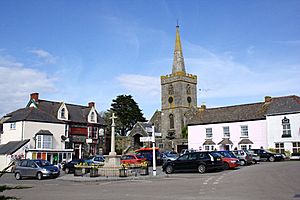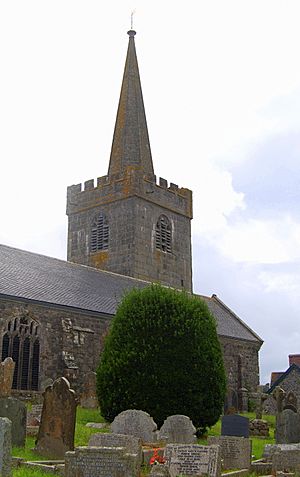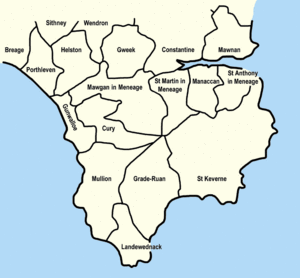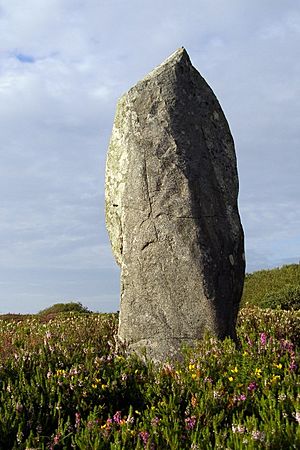St Keverne facts for kids
Quick facts for kids St Keverne
|
|
|---|---|
 St Keverne village square |
|
| Lua error in Module:Location_map at line 530: Unable to find the specified location map definition: "Module:Location map/data/Cornwall (mainland)" does not exist. | |
| Population | 2,147 (Civil Parish, 2011) |
| OS grid reference | SW789212 |
| Civil parish |
|
| Unitary authority | |
| Ceremonial county | |
| Region | |
| Country | England |
| Sovereign state | United Kingdom |
| Post town | Helston |
| Postcode district | TR12 |
| Dialling code | 01326 |
| Police | Devon and Cornwall |
| Fire | Cornwall |
| Ambulance | South Western |
| EU Parliament | South West England |
| UK Parliament |
|
St Keverne (in Cornish: Pluw Aghevran for the parish, and Lannaghevran for the village) is a village and a civil parish in Cornwall, England. It is located on The Lizard peninsula.
The area around St Keverne is also an electoral ward. This ward is called St Keverne and Meneage. It stretches all the way to the western Lizard coast near Gunwalloe. In 2011, about 5,220 people lived in this ward.
St Keverne is famous for being the starting point of the Cornish rebellion of 1497. The leader of this rebellion was Michael An Gof. He was a blacksmith from St Keverne. His name means "the smith" in Cornish. There is a statue of him in the village today. Before he was executed, An Gof said he wanted to have "a name perpetual and a fame permanent and immortal." In 1997, 500 years after the rebellion, a march called "Keskerdh Kernow 500" took place. It followed the same path as the original rebels, from St Keverne to London.
Contents
Exploring St Keverne's Geography
The parish of St Keverne is quite large. It includes about 10 miles of coastline. This stretches from Nare Point, near the Helford River, to Kennack Sands. The dangerous the Manacles rocks are also offshore.
Along the coast, you can find small settlements like Porthallow, Porthoustock, and Coverack. Inland, the parish has tiny villages called hamlets. These include Zoar, Laddenvean, Traboe, Trelan, and Gwenter. Part of Goonhilly Downs is also within the parish.
St Keverne is part of the Cornwall Area of Outstanding Natural Beauty (AONB). This means the area has special natural beauty and is protected.
The Historic Parish Church of St Akeveranus
In the Middle Ages, St Keverne was home to an important monastery. The church is named after St Akeveranus. For a long time, people mistakenly called him Kieran. The name Keverne was brought back during the Reformation.
The church is very big for a village church. Most of it was built in the 15th century. However, some stone parts seem to be from an older church building. It's unusual for Cornwall because its tower has a spire on top. Other interesting things to see are the old wooden bench ends and a wall painting.
Near the churchyard entrance, there is a large 32-pounder carronade. This is a type of cannon. Divers found it in 1978 from the wreck of HMS Primrose. The Primrose sank on The Manacles rocks on January 21, 1809. Sadly, 125 lives were lost, with only one survivor, a drummer boy.
The church has a set of ten bells. This is one of the largest sets of bells in a Cornish parish church. Until 2001, St Keverne had eight bells. Two more were added then.
Discovering St Keverne's Ancient History
People have lived in St Keverne for thousands of years. There is proof of human life here from at least 5550 BC. The area has many important archaeological sites. These include flint tools, pottery, ancient burial sites called cists, round houses, and cliff castles.
Life in Prehistoric Times
The Mesolithic Period (Middle Stone Age)
In 1967, a Mesolithic site was found at Poldowrian. It is known as Rock Mound. This site dates back to between 5550 and 5250 BC. Scientists found hazelnut pieces there that helped them figure out the age. Flint tools were first discovered when people tried to plow the land. Nearly 48,000 flint tools were found in total.
The Neolithic Period (New Stone Age)
During the Neolithic period and later, St Keverne was a main source of clay for making pottery. A special type of clay called Gabbroic clay covers about 7 square miles of the Lizard Peninsula. Most of this is in the St Keverne Parish. This clay is found about 8 to 18 inches below the topsoil. In the late 1960s, a scientist named Dr. D. Peacock studied many pottery pieces from Cornwall. He found that they were all made from the same gabbroic clay from St Keverne. Much of the ancient pottery from Cornwall, like pieces found at Carn Brea, was made from this clay.
Beaker Pottery Finds
St Keverne has given us a lot of Beaker pottery. The Beaker Mound at Poldowrian has one of the best collections of Beaker pottery found in Cornwall.
The Bronze Age
Goonhilly Downs has over 65 Bronze Age burial mounds called barrows. It also has the "Dry Tree Menhir," which is a standing stone. Another Bronze Age standing stone is at Tremenheere. This name means "Standing Stone Farm" in Cornish. Other old sites include a cist called the Three Brothers of Grugith on Crowza Downs. There was also a fogou (an underground passage) at Polkernogo, but it has been destroyed.
The Iron Age
St Keverne has several Iron Age sites. Two of the most impressive are the cliff castles of Chynalls and Lankidden. Today, only faint marks of the ditches and banks that protected these castles remain. But in the Iron Age, they were important places in a landscape full of settlements. Another important Iron Age item from St Keverne is a beautifully engraved bronze mirror. It was found in a cist grave in 1833. Along with the mirror, two brooches, some beads, and two rings were also found.
St Keverne in the Middle Ages
In Celtic times, St Keverne was part of the Meneage area. This area belonged to several small monasteries. The monastery at St Keverne continued after the Norman Conquest. However, it was soon taken over by a powerful lord.
By 1236, the churches and lands of Tregonan became the property of the Cistercian abbey at Beaulieu. This was a valuable possession. It included the church's share of crops from a large, wealthy parish, a share of fish, and the lands around the church. Beaulieu Abbey had the right of sanctuary, meaning people could find safety there. This right was also given to St Keverne. A small group of monks lived at Tregonan. Small parts of their building were still there until the early 1900s. In the parish, there is a place called Lesneague. Its name might come from Cornish words meaning "court" and "monks' land." This suggests it was once a chief's home.
Cornish Wrestling Champions
Cornish wrestling tournaments have been held in St Keverne for prizes.
James Polkinghorne (1788–1851) was born in St Keverne. He was one of the most famous champion Cornish wrestlers. He had many well-known matches against fighters from Devon. These included Flower, Jackman (in 1816), and Abraham Cann (in 1826). These matches attracted very large crowds, sometimes around 17,000 people!
Henry Cuttance (1807–?), also from St Keverne, was another champion Cornish wrestler. In 1846, he was the one who gathered local people to help rescue the crew of a Norwegian ship. The ship, called the Elizabeth of Bergen, had run aground.
Famous People from St Keverne
- Michael An Gof: A blacksmith and the leader of the first Cornish rebellion in 1497.
- Charles Incledon: A famous singer.
See also
 In Spanish: St Keverne para niños
In Spanish: St Keverne para niños






